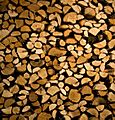Wood fuel facts for kids
Wood fuel is a type of energy source that comes from trees and other plants. When wood is burnt, it releases energy as heat and light. People have used wood for thousands of years to cook food, keep warm, and power early industries.
Contents
What is Wood Fuel?
Wood fuel includes many forms of wood, like firewood logs, wood chips, wood pellets, and even sawdust. It is a type of biomass fuel, which means it comes from living or recently living organisms. When wood burns, it releases the stored energy from the sun that the tree captured as it grew.
How Wood Fuel Works
Burning wood is a chemical process called combustion. When wood heats up, it releases gases that mix with oxygen in the air and ignite. This creates a flame and releases heat. The heat can be used in many ways, such as:
- Heating homes in fireplaces or stoves.
- Cooking food over a campfire or in a wood-fired oven.
- Generating electricity in power plants, though this is less common for wood alone.
Types of Wood Fuel
There are different ways wood is prepared for fuel:
- Firewood: These are logs or split pieces of wood, often used in homes. They need to be dry to burn well.
- Wood Chips: Smaller pieces of wood, often from leftover parts of trees after logging. They can be used in special boilers.
- Wood Pellets: These are small, compressed cylinders made from sawdust and wood waste. They are very dense and burn efficiently in pellet stoves.
- Charcoal: This is made by heating wood in a low-oxygen environment. It burns hotter and cleaner than raw wood and is often used for grilling.
History of Wood Fuel
Wood was one of the first fuels ever used by humans. For a very long time, it was the main source of energy for heating, cooking, and making tools.
- Ancient Times: Early humans used wood for campfires to stay warm, cook meat, and protect themselves from animals.
- Middle Ages: Wood was essential for blacksmiths to forge metal and for bakers to heat ovens. Forests were managed to provide a steady supply of wood.
- Industrial Revolution: As industries grew, the demand for wood increased. Charcoal made from wood was crucial for making iron and steel. Later, coal and then petroleum became more common fuels.
Wood Fuel Today
Even with modern fuels, wood is still an important energy source around the world.
- Developing Countries: In many parts of the world, especially in rural areas, wood is still the primary fuel for cooking and heating homes.
- Developed Countries: Wood is used for heating homes, often in wood-burning stoves or fireplaces. Wood pellets are also gaining popularity as a cleaner and more efficient option. Some power plants also use wood waste to generate electricity.
Benefits of Wood Fuel
- Renewable: Trees can be replanted, making wood a renewable resource if managed sustainably.
- Local Source: Wood can often be sourced locally, reducing the need to transport fuel long distances.
- Carbon Neutral (under certain conditions): When wood burns, it releases carbon dioxide. However, if new trees are planted to replace those harvested, these new trees absorb the same amount of carbon dioxide as the old ones released, making the process carbon neutral over time.
Challenges of Wood Fuel
- Air Pollution: Burning wood can release smoke and tiny particles into the air, which can cause air pollution and health problems if not burned efficiently or with proper ventilation.
- Deforestation: If forests are not managed sustainably, too much wood harvesting can lead to deforestation, harming ecosystems.
- Efficiency: Older fireplaces and stoves are not very efficient, meaning a lot of heat escapes up the chimney. Modern wood stoves and pellet stoves are much better.
Images for kids
-
Charcoal, a special form of wood fuel, was very important for making iron.
-
Stapled birch wood, ready to be used as fuel.
-
A wood-burning fireplace with a log burning inside.
-
Sawmills create sawdust as a byproduct, which can be turned into wood pellets for home use.
-
A pile of firewood logged from the Barmah Forest in Victoria, Australia.
See also
 In Spanish: Dendroenergía para niños
In Spanish: Dendroenergía para niños













